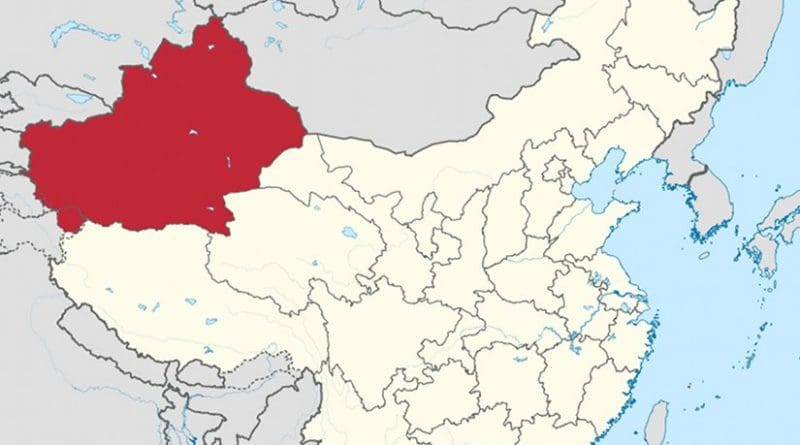Xinjiang’s July Syndrome: Terrorism Or Misgovernance? – Analysis
By IPCS
By Bhavna Singh
When Zhang Chunxian (Xinjiang’s current Communist Party Chief) took over as governor after hardliner Wang Lequan’s dismissal following the Urumqi riots in 2009, he was expected to usher in an era of peace and tranquility in Xinjiang’s Uyghur Autonomous Region (XUAR). For this purpose he adopted a soft-approach towards Uyghurs marking a strategic shift from the legacy of his predecessor. However, his endeavour to project stability and prosperity on the eve of the second anniversary of the Urumqi riots (5 July 2009), when he tried to reach out the local communities, was marred by a dreadful providence of events which unfolded on 18 and 30-31 July 2011 in Kashgar and Hotan. The Chinese government quickly adduced the terrorist angle to explain the incidents whereas the locals came up with a contrary view. What exactly are the major reasons causing these recurring disturbances? Is terrorism alone a valid explanation or are there graver issues which need to be addressed?
So far, China’s attempts at integrating the province and creating a harmonious socio-political environment by increasing the security budget along with a ‘one-on-one/pairing assistance programme’ carried out by the XPCC have drastically failed. This is primarily because the consequential political reshuffle did not take the aspirations of the local people into account. It is plausible that public punishments meted out to the members of the Uyghur community left a humiliating impact on community psyche, following which they decided to take revenge (Reports in The New York Times of a video of the Turkistan Islamic Party claiming revenge confirms this: http://nyti.ms/nGy1xv). Also, the relaxation of media norms within the province gave them an opportunity to regroup with previous affiliations, who too shared a feeling of persecution by the Chinese state.
Mismanagement of economic resources has also been fuelling the fury of ethnic minorities in the region. Kashgar as one of the latest cities to be modernized and being declared as a Special Economic Zone last year became a significant investment opportunity for one and all. Given its favourable business environment, it attracted investors on a large scale, mostly Han officials, volunteers, merchants, police and immigrant workers which contributed to the rising cost of living in the city.
It is estimated that in the last two years the housing prices have doubled in Kashgar. Local businessmen and officials have become eager to demolish old buildings and community structures and replace them with skyscrapers. Beijing will be investing another 7.26 billion Yuan ($1.13 billion) in municipal infrastructure construction and other livelihood programmes in Hotan Since most Uyghurs are unable to ‘upgrade’ their apartments to new ones, they are increasingly marginalized in their own town. They also lament the grave cultural erosion, most prominently seen in the traditional Islamist part of the city which is being modernized at a fast pace. The Chinese government further plans to increase the city’s annual GDP growth rate over the next decade and increase the population from the current six hundred thousand to a million by 2030. These changes are leading to increased antagonism between the Central government and the local people.
Additionally, the entire process of rehabilitation lacks transparency and the locals are not adequately compensated during the renovation phase which leads to adverse speculations on the state’s intention for the region. The state’s decision to provide access to foreign investors further undermines the interests of the locals. The gap between the rich and the poor is widening progressively and the discrepancy between real political rights and the privileges mentioned under the constitution of the People’s Republic of China is also mounting.
A common complaint in the religious realm is that being Uyghur citizens it takes almost six months to a year’s time to get a passport which is generally sought for the purpose of Hajj, the holy journey to Mecca, and sometimes they are not able to get the passport at all. The locals believe that this is done purposefully to deny them access to their pan-Islamist linkages which might be revived on their way to Muslim countries.
The high level of corruption amongst the local police is also a significant determinant of the attack on the police station in Hotan. Police officials are believed to be involved in a black economy whereby they manoeuvre and deploy the discourse of ‘three forces of evil’: separatism, extremism and terrorism, as and when it suits their need. They are involved in a double-sided pursuit of money from the locals as well as the state. Hence they are particularly being targeted by the local people.
Though a larger terrorist threat exists from pan-Islamist linkages in the Central Asian Region, the Chinese authorities are amenable to playing up the ‘terrorist threat’ being instigated from abroad and by the East Turkestan Islamic movement (ETIM)/Tu-Dong forces to garner international support. These incidents should therefore not be viewed from the prism of terrorism but as clashes engendered by ruthless suppression of peaceful protestors by the local police and officials while demonstrating on day-to-day issues.
On the whole the July 2011 incidents seem largely driven by misgovernance in addition to the fundamental ethnic divide that exists in Xinjiang and should not be construed within the larger terrorist threat to the Chinese state.
Bhavna Singh
Research Officer, IPCS
email: [email protected]


Yeah, when US gets attacked, its terrorism. When China gets attacked, its an uprising. Nice logic.